Joy Neal Kidney's Blog, page 56
March 2, 2022
The Retreat: For Nervous Invalids, Des Moines, Founded 1905
I’m working on the manuscript for Leora’s Early Years and still discovering the man she married in 1914, Clabe Wilson. This is about his mother, Georgia.
Georgia Wilson, widow of Dan Wilson of Guthrie County, Iowa, just wasn’t regaining her health after some kind of surgery a few years earlier. In 1917, her three oldest children were married, and she was trying to make a home for her younger daughters, Fonnie (14) and Verna (10).
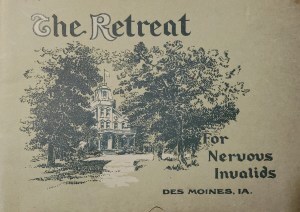
Her doctor recommended that she try The Retreat, a private mental hospital at 28th and Woodland Avenue in Des Moines.

The main building was the old Callanan mansion, named James Callanan, an early Des Moines capitalist, involved with insurance and real estate. An article published in 1904, just after his death, said “James Callanan, the late millionaire philanthropist, left his home for drunkards’ wives and widows.”
Dr. Gershom Hill and Dr. John Doolittle, who had been in charge of the state hospital at Independence, began what was sometimes called Hill’s Retreat in 1905. They believed that being able to live in home-like surroundings helped those with nervous and mental disorders. Patients not needing hospitalization lived in five cottages, where nurses were on duty. A woman could have her children with her, and they were allowed to roam the 17-acre grounds, where gardeners tended the orchards and vegetable gardens that supplied the institution.
It cost $125 a month for Georgia to live there with her two younger daughters.
But four months later, Georgia Wilson was worse. J. P. Fox was named as temporary guardian for the young sisters, although they lived family members. The youngest one lived with her brother Clabe and his little family for a while.
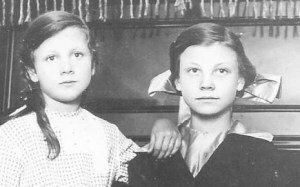
On November 9, Georgia Wilson, age 52, was admitted to Clarinda State Hospital, where her husband had died in 1909. She died there two weeks later.
Both of Clabe Wilson’s parents had difficult lives during his young adulthood, while he was beginning his own family. It was the same situation for Rectha and Alice. We will learn that Fonnie and Verna became well-adjusted adults. Don’t know wish you knew the family story from their points of view?
February 28, 2022
DNA Results
After being contacted by someone claiming descent from the bachelor brother of m great grandfather, I finally bought a kit through 23andMe.
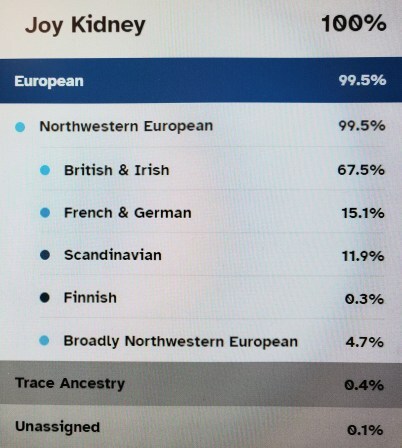
I did find first cousins, second cousins, and many more names that I don’t recognize.
I didn’t find the woman who’d contacted me. She must have used a kit from a different company. But ALL of her information checked out! She shared documents with me about where our common great grandmother is buried, which I hadn’t found. This Florida attorney and wants to eventually tell their story. She and her mother wept together over as they talked on the phone, after learning they do belong to a real family.
My chart looks a little tame, doesn’t it? I began my genealogy journey about 1968 and “chased ancestors” until our son was born in 1974, so I knew about most of this. But Finnish?
There are stories behind those numbers! German. More German. English. Irish.
My German ancestors, the last ones to arrive (1870), came from Schleswig-Holstein. It was part of Germany when they packed up and sailed over, but when the older generation was born, it was part of Denmark. So are we German or Dane? Guess it fits into “Broadly Northwestern Europe.”
Finnish? hmmm
February 26, 2022
Smallpox! 100 Years Ago
A hundred years ago, smallpox was a growing concern in Guthrie County, Iowa. The clippings are from The Stuart Herald, February 17, 1922.
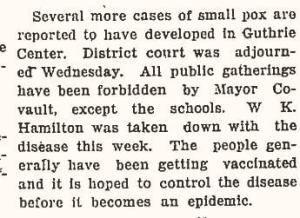 It’s interesting that public gatherings were forbidden and that the district court was adjourned, but youngsters were still allowed to go to school.
It’s interesting that public gatherings were forbidden and that the district court was adjourned, but youngsters were still allowed to go to school.
Smallpox was a terrible disease, according to the CDC. On average, 3 out of every 10 people who got it died. People who survived usually had scars, sometimes severe.
According to the Mayo Clinic, smallpox is “a contagious, disfiguring and often deadly disease that has affected humans for thousands of years. Naturally occurring smallpox was wiped out worldwide by 1980 — the result of an unprecedented global immunization campaign.”
The smallpox vaccine was the first to be developed against a contagious disease.
Clabe and Leora Wilson lived in Stuart, which in southern Guthrie County. The twins were 10 months old, Delbert and Donald were in first grade, and Doris would turn 4 in August. The children were vaccinated for smallpox, perhaps their parents were as well. The nurse or doctor told Doris that it wouldn’t hurt, but it did. She was shocked that they’d not told her the truth.
Carried by Cats?
People wondered whether the disease could be spread by neighborhood cats. An adult man died from smallpox, as well as three children. No wonder Guthrie County folks were anxious to get vaccinated.
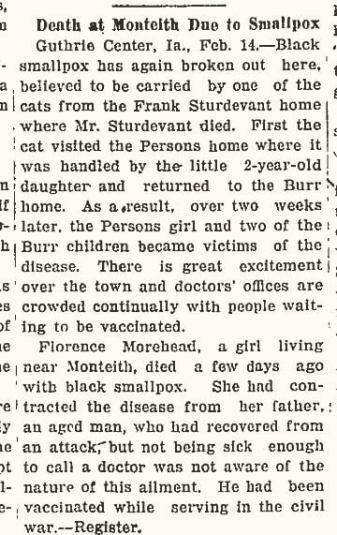
Florence Morehead, called a girl in the clipping, was 23 years old when she died of this miserable virus. Her father endured a milder case because of being vaccinated during the Civil War six decades earlier.
We were vaccinated for smallpox during the 1950s, but our son born in 1974 wasn’t.

The smallpox vaccination was administered on the upper arm with a series of needle pricks in a circle, then the serum was daubed onto the area and covered with a bandage. It would cause a blister which would eventually fall off, leaving the circular scar as evidence of the vaccination.
Mayo Clinic: “No cure or treatment for smallpox exists. A vaccine can prevent smallpox, but the risk of the vaccine’s side effects is too high to justify routine vaccination for people at low risk of exposure to the smallpox virus.”
Google photos of people with smallpox. I just couldn’t include one here. I’m so thankful we don’t have to dread such an awful disease.
Smallpox!–100 Years Ago
A hundred years ago, smallpox was a growing concern in Guthrie County, Iowa. The clippings are from The Stuart Herald, February 17, 1922.
 It’s interesting that public gatherings were forbidden and that the district court was adjourned, but youngsters were still allowed to go to school.
It’s interesting that public gatherings were forbidden and that the district court was adjourned, but youngsters were still allowed to go to school.
Smallpox was a terrible disease, according to the CDC. On average, 3 out of every 10 people who got it died. People who survived usually had scars, sometimes severe.
According to the Mayo Clinic, smallpox is “a contagious, disfiguring and often deadly disease that has affected humans for thousands of years. Naturally occurring smallpox was wiped out worldwide by 1980 — the result of an unprecedented global immunization campaign.”
The smallpox vaccine was the first to be developed against a contagious disease.
Clabe and Leora Wilson lived in Stuart, which in southern Guthrie County. The twins were 10 months old, Delbert and Donald were in first grade, and Doris would turn 4 in August. The children were vaccinated for smallpox, perhaps their parents were as well. The nurse or doctor told Doris that it wouldn’t hurt, but it did. She was shocked that they’d not told her the truth.
Carried by Cats?
People wondered whether the disease could be spread by neighborhood cats. An adult man died from smallpox, as well as three children. No wonder Guthrie County folks were anxious to get vaccinated.

Florence Morehead, called a girl in the clipping, was 23 years old when she died of this miserable virus. Her father endured a milder case because of being vaccinated during the Civil War six decades earlier.
We were vaccinated for smallpox during the 1950s, but our son born in 1974 wasn’t.

The smallpox vaccination was administered on the upper arm with a series of needle pricks in a circle, then the serum was daubed onto the area and covered with a bandage. It would cause a blister which would eventually fall off, leaving the circular scar as evidence of the vaccination.
Mayo Clinic: “No cure or treatment for smallpox exists. A vaccine can prevent smallpox, but the risk of the vaccine’s side effects is too high to justify routine vaccination for people at low risk of exposure to the smallpox virus.”
Google photos of people with smallpox. I just couldn’t include one here. I’m so thankful we don’t have to dread such an awful disease.
February 24, 2022
Typewriters in the Family
I’ll bet most of you know how to type.
It must have been the fall of 1958 when I took at least a semester of typing. Earlham High School had just gotten one or two electric typewriters, so we took turns with the wonderful new gadgets.
 Mom got a Facit portable typewriter to use at home, which is how I typed my school papers–even footnotes. I spent my graduation money on a Facit of my own, which saw me through college and beyond. Yes, I still have it. Maybe Granddaughter Kate will enjoy it when she gets old enough.
Mom got a Facit portable typewriter to use at home, which is how I typed my school papers–even footnotes. I spent my graduation money on a Facit of my own, which saw me through college and beyond. Yes, I still have it. Maybe Granddaughter Kate will enjoy it when she gets old enough.
 The next one was electric! A Corona XL with cartridges for the ribbon and a correcting tape. Bliss! It’s “portable” but terribly cumbersome and heavy, but electric! (For some reason, I still have this one. Maybe because we’ve lived in the same house 45 years.)
The next one was electric! A Corona XL with cartridges for the ribbon and a correcting tape. Bliss! It’s “portable” but terribly cumbersome and heavy, but electric! (For some reason, I still have this one. Maybe because we’ve lived in the same house 45 years.)
When our son Dan got interested in computers, our first one was a MacPlus. What a rigamarole with those floppy discs, but what a joy to work with.
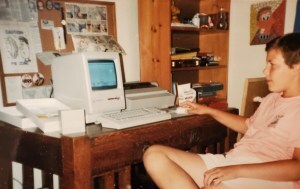 Dan and the Mac Plus, which is on the antique library table from the Goff family’s Victorian house in Guthrie Center
Dan and the Mac Plus, which is on the antique library table from the Goff family’s Victorian house in Guthrie CenterThis is what I used to transcribe the WWII letters, making copies for the four surviving siblings. I hadn’t planned at that point to write a book. I needed to do a lot of research and learn to write well enough, which took at least a couple of decades.
Now I use a terrific Dell desktop computer, but I’m charmed by an old Royal typewriter my husband found and cleaned up. This one probably dates from the 1940s, so is as old as I am.
It’s fun to use it as props for books and other stuff.
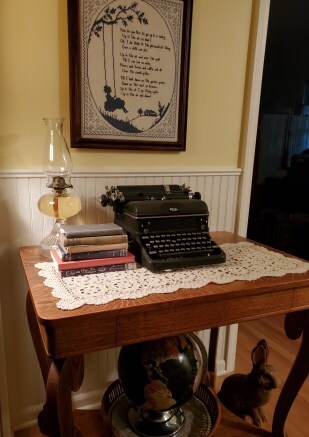
Our childhood globe from the 1950s sits underneath. My husband refinished the library table, which my folks bought from a neighbor in rural Dallas County when Dad got home from WWII.
Oh, my piano teacher typed her son’s papers, at least while he was in high school. He became a doctor so probably dictated anything he needed typed. But I decided I was NOT going to type my son’s assignments so made sure he took a semester of keyboarding. That was one great decision! (I bet he’d agree.)
February 21, 2022
Frog Pond School
Iowa rural schools in Iowa, marked on the old maps, were planned so that students wouldn’t have to walk farther than two miles to attend classes. They were usually just one-room structures with an area to hang “wraps” and park lunch pails.
Clabe Wilson and his sisters, Rectha and Alice, attended Frog Pond School.
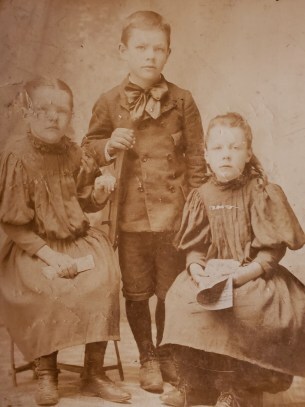 Rectha Mae (1890), Claiborne Daniel (1888), and Alice Madeline (1891) Wilson, Guthrie County, Iowa. Photo probably taken in Panora before 1900.
Rectha Mae (1890), Claiborne Daniel (1888), and Alice Madeline (1891) Wilson, Guthrie County, Iowa. Photo probably taken in Panora before 1900.
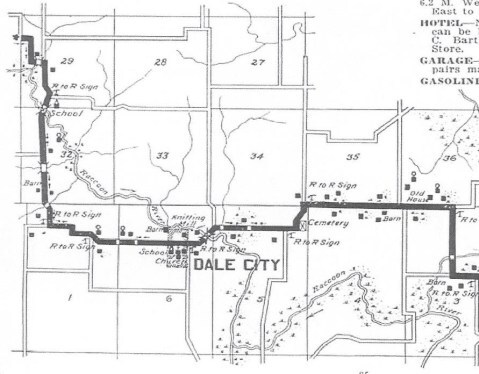
The Wilsons farmed in Section 28 in Jackson Township, Guthrie County. I believe that Frog Pond School is in the southwest corner of Section 29 in this old map.
One of Clabe Wilson’s schoolmates there was Wesley Clampitt, who became the Superintendent of the Dexter School when Clabe’s children attended there during the Great Depression. He is mentioned in Leora’s Dexter Stories.
At one time, more than 12,000 rural schools dotted the Iowa landscape, most two miles apart. Today some are in use as houses or farm buildings, others as township halls and community centers. Many have been preserved as museums.
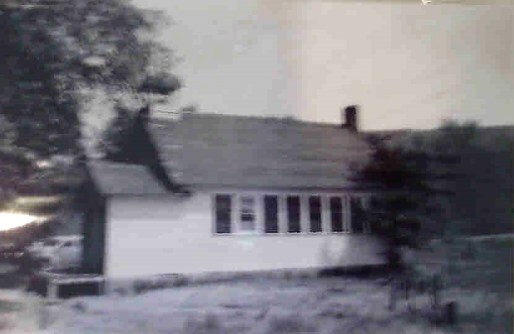 Thanks to Kenneth Wheeler for providing a photo of this school, also known as Glendon Independent School #5
Thanks to Kenneth Wheeler for providing a photo of this school, also known as Glendon Independent School #5A piece of the school foundation was erected on the site marks the area where Frog Pond School used to stand.

It was fun to learn that former Frog Pond students gathered for reunions as late as 2007. This one was held at The Port Restaurant in Panora.
 The Vedette, October 18, 2007
The Vedette, October 18, 2007A tribute to the endearment of the community and rural beauty of Guthrie County, Iowa.
February 19, 2022
Bonnie Reads and Writes, Self-Published Saturday: Leora’s Letters

Self-Published Saturday is my effort to help self-published/indie authors. Self-published authors have to do it all, from editing to cover design to marketing. If I can help even a little bit with the marketing, I’m happy to do it. Below is a review of Leora’s Letters by Joy Neal Kidney. This is the heartbreaking story of a mother whose sons went off to war, and some of them did not return.
BOOK REVIEW
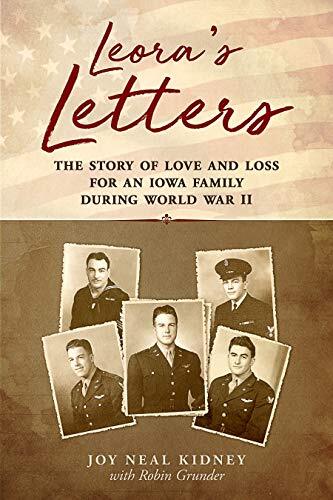

This is a heartbreaking look back at the real lives and losses of the family of Clabe and Leora Wilson, who were tenant farmers with seven living children at the start of the story. The prologue begins with the living family members putting flowers on the graves for “decoration day,” and we learn that they lost three sons and brothers in World War II. Photos and biographies of the Wilsons’ seven children who had lived to adulthood are also included. I had first gotten to know Leora’s family by reading book two, Leora’s Dexter Stories, which is a prequel. Leora and Clabe had already lost three of their ten children in infancy, and it broke my heart to see their additional loss and suffering in Leora’s Letters. In all, the Wilsons lost six of their ten children, three of them during World War II. But this is not just about loss. This is about a family that worked very hard to survive and always supported each other no matter what. The letters they all wrote to each other throughout the war are a testament to that love and support, as well as the closeness they all enjoyed.
Through their actual letters, we follow these sons and the entire family as the war progresses. And we see not only separation and suffering, but we witness the remaining family members doing backbreaking work, with the majority of their efforts going to the people who actually owned the farm. It is a testament to the way life was back then for working men and women. But this book is also about love and perseverance in the midst of all of the pain. It is a well-researched account of some of the significant events of World War II, and it will transport you back in time to the bloodiest war in history where over 60 million people died. Ultimately, it will introduce you to a loving and remarkable American farming family that made the ultimate sacrifice over and over and over again.
The research and writing of Joy Neal Kidney, and her willingness to share her family story with the world, are to be commended.
I downloaded a copy of this book on Kindle Unlimited, where subscribers can read it for free.
ABOUT THE AUTHOR
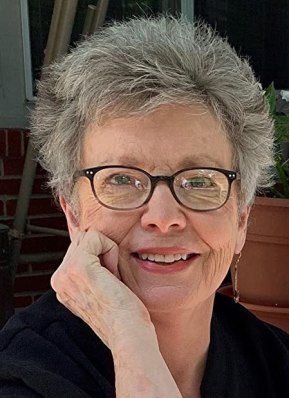 Joy Neal Kidney
Joy Neal Kidney(In her own words) I am the keeper of family stories, letters, pictures, research, combat records, casualty reports, and terrible telegrams. Active on several history and military Facebook pages, I help administer local ones–Audubon County, Dallas County, and Guthrie County, Iowa–the places where my motherline stories originated, as well as Depression Era Iowa.
Born two days before D-Day to an Iowa farmer who became an Army Air Corps pilot, then an instructor–with orders for combat when the war ended–and an Iowa waitress who lost three of her five brothers during that war. I spent my childhood in an Iowa farmhouse with a front porch. Now I live with my husband, a Vietnam veteran, in a suburban house with a front porch.
I’ve published two books (“Leora’s Letters: The Story of Love and Loss for an Iowa Family During World War II” and “Leora’s Dexter Stories: The Scarcity Years of the Great Depression.”) I’m a regular contributor to Our American Stories.
LINKS
BUY LEORA’S DEXTER STORIES ON AMAZON
My review of Leora’s Dexter Stories is here

*If you buy the book(s), please leave reviews on Amazon and Goodreads, as well as anywhere else you review books. Some people feel very daunted by writing a review. Don’t worry. You do not have to write a masterpiece. Just a couple of lines about how the book made you feel will make the author’s day and help the book succeed. The more reviews a book has, the more Amazon will promote it.
I’m so thankful for this review, on the anniversary of the loss of Danny Wilson in 1945.
Here is Bonnie’s website.
Recent Visitors to the Grave of Lt. Daniel S. Wilson in France
Daniel S. Wilson, a farm kid from Minburn, Iowa, who became the pilot of a P-38 Lightning in World War II, was Killed in Action on this date in 1945.
 Gaston and Bernard Adier, at Lt. Daniel S. Wilson’s grave, Lorraine American Cemetery, St. Avold, France. February 13, 2022
Gaston and Bernard Adier, at Lt. Daniel S. Wilson’s grave, Lorraine American Cemetery, St. Avold, France. February 13, 2022A week ago, brothers Gaston and Bernard Adier, along with Gaston’s wife, paid their respects to young Americans who are buried in the nearby Lorraine American Cemetery at St. Avold. Gaston Adier is the mayor of Carling, France, which is about four miles from St. Avold. They have taken the time to do this before.
They regularly visit the grave of Danny Wilson and send us a photo, this time including historic information: “Le 19 février 1945, son P-38 est perdu après une mission d’escorte à Vienne, puis mitraillage dans la région de Graz. Il a été perdu près de Schwanberg, en Autriche. Des témoins oculaires ont déclaré qu’il était difficile de repérer un avion argenté dans une zone enneigée. Le lieutenant Daniel S. Wilson a été répertorié comme MIA à partir de cette date jusqu’en janvier 1946. À ce moment-là, l’armée avait reçu des informations provenant de documents allemands capturés par l’intermédiaire d’une équipe britannique d’enregistrement des tombes, transmises à une équipe américaine d’enregistrement des tombes qui a suivi en novembre 1945. Ses parents ont été avisés en janvier 1946. Sa dépouille a été transportée d’Autriche en août 1946 au cimetière temporaire puis définitif américain de Lorraine à Saint-Avold, en France.”
Translation: “On February 19, 1945, his P-38 was lost after an escort mission in Vienna, then strafing a train iin the Graz region. Lost at Schwanberg, Austria. Eyewitnesses said it was difficult to spot a silver plane in a snowy area. Lieutenant Daniel S. Wilson was listed as MIA from this date until January 1946. At that time, the army had received information from German documents captured through a British grave recording team, transmitted to an American grave recording team that followed in later 1945. His parents were notified in January 1946. His remains were transported from Austria in August 1946 to the temporary, then final American cemetery of Lorraine in Saint-Avold, France.”
—–
Remembering Daniel S. Wilson on this anniversary of his loss.

February 16, 2022
Grandma Ruby Neal’s Wicker Baskets
 Grandma Neal at my bridal shower, 1966
Grandma Neal at my bridal shower, 1966Grandma Ruby Neal’s shower gifts to her granddaughters, and to brides of her grandsons, were wicker baskets. Inside she’d added a small pad of paper and a pencil (for grocery lists) and a treated cloth (for dusting).
 Leaving for school, 1969 or 1970
Leaving for school, 1969 or 1970The right-sized basket with a handle is such a handy thing to have around. Mine, dating from 1966, has been to probably every potluck we’ve ever attended. It’s carried quilt squares and counted cross-stitch, crocheting and knitting projects.
When Guy was in Vietnam and I taught second grade, it went back and forth to school with me.
These days it carries poster holders, pens for autographing, and business cards when I give programs about the Wilson family stories during the Great Depression and WWII, or about the Dallas County Freedom Rock.
It’s still surprisingly sturdy, although the handle wrapping came undone so is now sheathed with fake leather.

The only thing better than an heirloom is an heirloom with a story!
February 14, 2022
Valentine’s Day, 1936
The year 1936 is still known for its temperature extremes. It snowed nearly a foot in January, and the temperature plummeted to 28 degrees below zero. That began the most frigid three weeks in Des Moines’s history.
After two weeks of arctic weather, more snow swept through the area, causing a coal shortage. Clabe Wilson and son Dale cut down an apple tree and hauled it home on a sled to tide the family over until they could find coal. The Dexter school closed for several days, and what coal they had was handed out to families who needed it.
The Dallas County News, Feb. 12, 1936: “Second Blizzard Rages. Mercury drops 30 degrees in a few hours. Train unable to get through. The WPA men cleared the road to the gravel pit near Redfield, only to have it drift shut again.” The Perry Daily Chief reported bitter subzero weather, with the railroads trying desperately to restore service. Buses also stalled.
“Heck, no!”
Clabe helped clear the road to the cemetery for a funeral. The thermometer read minus 20 degrees on Valentine’s Day. Youngest son Junior prepared to take a Valentine for each boy in his room at school.
Leora joked, “My, haven’t you any girlfriends?”
 Dale, Danny, and Junior Wilson later that year with Spats
Dale, Danny, and Junior Wilson later that year with Spats“Heck, no!” He brought home a big orange from his teacher and about ten Valentines.
Danny, two years older than Junior, said his grade doesn’t do such little things anymore. But his teacher gave a candy bar to each student, chocolate and black walnut, made in Drew’s Candy Kitchen right there in Dexter.
—–
Helen Drew made her first chocolates in 1927, and Drew’s Chocolates is still in business, along the highway in Dexter.
From Leora’s Dexter Stories: The Scarcity Years of the Great Depression



